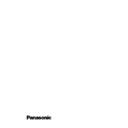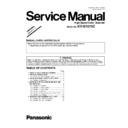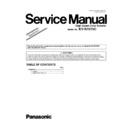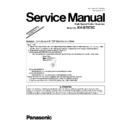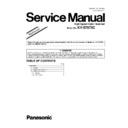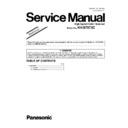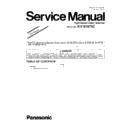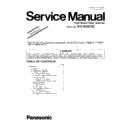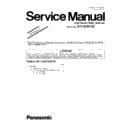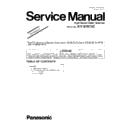Read Panasonic KV-S7075C (serv.man2) Service Manual online
Order Number KM70811445CE
Category Number
G14
High Speed Color Scanner
Model No.
KV-S7075C
2
TABLE OF CONTENTS
PAGE
PAGE
1 GENERAL PRECAUTIONS -------------------------------------3
1.1. Safety Precautions-----------------------------------------3
1.2. Electrical Tests ----------------------------------------------3
1.3. Standard for Repair Service -----------------------------3
1.4. For Service Technicians ----------------------------------4
1.5. About Lead Free Solder (PbF: Pb free) --------------4
1.6. About RoHS -------------------------------------------------4
1.2. Electrical Tests ----------------------------------------------3
1.3. Standard for Repair Service -----------------------------3
1.4. For Service Technicians ----------------------------------4
1.5. About Lead Free Solder (PbF: Pb free) --------------4
1.6. About RoHS -------------------------------------------------4
2 SPECIFICATIONS -------------------------------------------------5
3 COMPONENT IDENTIFICATION ------------------------------7
4 INSTALLATION--------------------------------------------------- 10
3 COMPONENT IDENTIFICATION ------------------------------7
4 INSTALLATION--------------------------------------------------- 10
4.1. Minimum Space Requirements ----------------------- 10
4.2. Installing Hopper Tray----------------------------------- 11
4.3. DIMM Module Extension ------------------------------- 14
4.4. Installing DIMM Modules ------------------------------- 16
4.5. Connecting the Scanner to a Personal
4.2. Installing Hopper Tray----------------------------------- 11
4.3. DIMM Module Extension ------------------------------- 14
4.4. Installing DIMM Modules ------------------------------- 16
4.5. Connecting the Scanner to a Personal
Computer--------------------------------------------------- 17
4.6. Reversing Flatbed Sheet (as required) ------------- 18
4.7. System Requirements ---------------------------------- 19
4.8. Installing Driver and Software------------------------- 19
4.7. System Requirements ---------------------------------- 19
4.8. Installing Driver and Software------------------------- 19
5 SECTIONAL VIEWS--------------------------------------------- 20
5.1. CIS (Contact Image Sensor) -------------------------- 20
5.2. Rollers------------------------------------------------------- 20
5.3. Drive Belts ------------------------------------------------- 21
5.4. Boards ------------------------------------------------------ 22
5.2. Rollers------------------------------------------------------- 20
5.3. Drive Belts ------------------------------------------------- 21
5.4. Boards ------------------------------------------------------ 22
6 MECHANICAL FUNCTION ------------------------------------ 24
6.1. Paper Feed Mechanism (Auto) ----------------------- 24
6.2. Paper Feed Mechanism (Manual) ------------------- 25
6.3. Paper Feed Roller / Hopper Lift Drive
6.2. Paper Feed Mechanism (Manual) ------------------- 25
6.3. Paper Feed Roller / Hopper Lift Drive
Mechanism------------------------------------------------- 25
6.4. Hopper Lift Mechanism --------------------------------- 26
6.5. Carriage Drive Mechanism ---------------------------- 26
6.5. Carriage Drive Mechanism ---------------------------- 26
7 MAINTENANCE -------------------------------------------------- 27
7.1. Maintenance----------------------------------------------- 27
7.2. Cleaning ---------------------------------------------------- 28
7.3. Replacing Limited Life Parts--------------------------- 37
7.2. Cleaning ---------------------------------------------------- 28
7.3. Replacing Limited Life Parts--------------------------- 37
8 DISASSEMBLY INSTRUCTIONS---------------------------- 39
8.1. Disassembly Flowchart --------------------------------- 39
8.2. Disassembly for Flatbed Block ----------------------- 42
8.3. Disassembly for ADF Block --------------------------- 59
8.2. Disassembly for Flatbed Block ----------------------- 42
8.3. Disassembly for ADF Block --------------------------- 59
9 SERVICE UTILITY & SELF TEST --------------------------- 91
9.1. Main Menu Indication for Service Utility ------------ 91
9.2. List of Functions for Service Utility------------------- 92
9.3. Operation--------------------------------------------------- 94
9.4. Scanner Self-test --------------------------------------- 105
9.2. List of Functions for Service Utility------------------- 92
9.3. Operation--------------------------------------------------- 94
9.4. Scanner Self-test --------------------------------------- 105
10 TROUBLESHOOTING ---------------------------------------- 109
10.1. Troubleshooting-1 (when no error message is
displayed on PC) --------------------------------------- 109
10.2. Troubleshooting-2 (when an error message is
displayed on PC) ----------------------------------------111
10.3. Requirement After Parts Replacement ----------- 126
11 CIRCUIT DESCRIPTION ------------------------------------- 127
11.1. Block Diagram-1 (Image Processing)------------- 127
11.2. Block Diagram-2 (Board) ----------------------------- 128
11.3. Explanation of Connector ---------------------------- 129
11.2. Block Diagram-2 (Board) ----------------------------- 128
11.3. Explanation of Connector ---------------------------- 129
12 SCHEMATIC DIAGRAM-------------------------------------- 146
12.1. CONTROL Board -------------------------------------- 147
12.2. CENTER Board----------------------------------------- 165
12.3. DRIVE Board -------------------------------------------- 175
12.2. CENTER Board----------------------------------------- 165
12.3. DRIVE Board -------------------------------------------- 175
12.4. RELAY Boards ------------------------------------------178
12.5. PANEL and SENSOR Boards -----------------------183
12.6. POWER Board ------------------------------------------193
12.5. PANEL and SENSOR Boards -----------------------183
12.6. POWER Board ------------------------------------------193
13 CIRCUIT BOARDS ---------------------------------------------194
13.1. CONTROL Board--------------------------------------- 195
13.2. CENTER Board -----------------------------------------197
13.3. DRIVE Board --------------------------------------------198
13.4. CIS (F) RELAY Board ---------------------------------199
13.5. CIS (B) RELAY Board ---------------------------------199
13.6. CIS (B) LED RELAY Board---------------------------200
13.7. SIZE DETECTOR Board------------------------------201
13.8. POWER RELAY Board--------------------------------202
13.9. PANEL Board --------------------------------------------202
13.2. CENTER Board -----------------------------------------197
13.3. DRIVE Board --------------------------------------------198
13.4. CIS (F) RELAY Board ---------------------------------199
13.5. CIS (B) RELAY Board ---------------------------------199
13.6. CIS (B) LED RELAY Board---------------------------200
13.7. SIZE DETECTOR Board------------------------------201
13.8. POWER RELAY Board--------------------------------202
13.9. PANEL Board --------------------------------------------202
13.10. DOCUMENT COVER DETECTOR Board -------202
13.11. WAITING SENSOR Board ---------------------------203
13.12. CARRIAGE HOME DETECTOR Board-----------203
13.13. SENSOR RELAY Board ------------------------------204
13.14. OUTER CONVEYOR RELAY Board---------------205
13.15. STARTING SENSOR Board -------------------------205
13.16. ENDING SENSOR Board ----------------------------205
13.17. HOPPER HOME DETECTOR Board-------------- 206
13.18. HOPPER RELAY Board ------------------------------207
13.19. POWER Board ------------------------------------------208
13.13. SENSOR RELAY Board ------------------------------204
13.14. OUTER CONVEYOR RELAY Board---------------205
13.15. STARTING SENSOR Board -------------------------205
13.16. ENDING SENSOR Board ----------------------------205
13.17. HOPPER HOME DETECTOR Board-------------- 206
13.18. HOPPER RELAY Board ------------------------------207
13.19. POWER Board ------------------------------------------208
14 PARTS LOCATION AND MECHANICAL PARTS
LIST ----------------------------------------------------------------209
14.1. Exterior ----------------------------------------------------210
14.2. ADF (Outer) ----------------------------------------------212
14.3. ADF (Inner)-----------------------------------------------215
14.4. Flatbed ----------------------------------------------------218
14.5. Board Assembly & Power Unit ----------------------221
14.6. Packing----------------------------------------------------223
14.7. Tool ---------------------------------------------------------225
14.2. ADF (Outer) ----------------------------------------------212
14.3. ADF (Inner)-----------------------------------------------215
14.4. Flatbed ----------------------------------------------------218
14.5. Board Assembly & Power Unit ----------------------221
14.6. Packing----------------------------------------------------223
14.7. Tool ---------------------------------------------------------225
15 REPLACEMENT PARTS LIST ------------------------------226
15.1. CONTROL Board--------------------------------------- 226
15.2. CENTER Board -----------------------------------------240
15.3. DRIVE Board --------------------------------------------254
15.4. CIS (F) RELAY Board ---------------------------------257
15.5. CIS (B) RELAY Board ---------------------------------258
15.6. CIS (B) LED RELAY Board---------------------------260
15.7. SIZE DETECTOR Board------------------------------260
15.8. POWER RELAY Board--------------------------------260
15.9. PANEL Board --------------------------------------------260
15.2. CENTER Board -----------------------------------------240
15.3. DRIVE Board --------------------------------------------254
15.4. CIS (F) RELAY Board ---------------------------------257
15.5. CIS (B) RELAY Board ---------------------------------258
15.6. CIS (B) LED RELAY Board---------------------------260
15.7. SIZE DETECTOR Board------------------------------260
15.8. POWER RELAY Board--------------------------------260
15.9. PANEL Board --------------------------------------------260
15.10. DOCUMENT COVER DETECTOR Board -------261
15.11. WAITING SENSOR Board ---------------------------261
15.12. CARRIAGE HOME DETECTOR Board-----------261
15.13. SENSOR RELAY Board ------------------------------261
15.14. OUTER CONVEYOR RELAY Board---------------262
15.15. STARTING SENSOR Board -------------------------263
15.16. ENDING SENSOR Board ----------------------------263
15.17. HOPPER HOME DETECTOR Board-------------- 263
15.18. HOPPER RELAY Board ------------------------------263
15.19. Power Board ---------------------------------------------263
15.13. SENSOR RELAY Board ------------------------------261
15.14. OUTER CONVEYOR RELAY Board---------------262
15.15. STARTING SENSOR Board -------------------------263
15.16. ENDING SENSOR Board ----------------------------263
15.17. HOPPER HOME DETECTOR Board-------------- 263
15.18. HOPPER RELAY Board ------------------------------263
15.19. Power Board ---------------------------------------------263
3
1 GENERAL PRECAUTIONS
1.1.
Safety Precautions
1. Before servicing, unplug the power cord to prevent electrical shock hazard.
2. When replacing parts, use only manufacture’s recommended components for safety.
3. Check the condition of power cord. Replace if wear or damage is evident.
4. After servicing, be sure to restore the wire dressing, insulation barriers, insulation papers, shields, etc.
2. When replacing parts, use only manufacture’s recommended components for safety.
3. Check the condition of power cord. Replace if wear or damage is evident.
4. After servicing, be sure to restore the wire dressing, insulation barriers, insulation papers, shields, etc.
5. Before returning the serviced equipment to the customer, perform the following electrical tests to prevent shock hazard.
1.2.
Electrical Tests
1. Unplug the power cord and check for continuity between the earth ground connection on the plug and the metal cabinet.
There should be zero ohm resistance found.
2. With the unit unplugged, short the AC Live-Neutral of the plug with a jumper wire.
3. Turn ON the power switch.
4. Measure the resistance value with an ohmmeter between the jumpered AC plug and each exposed metal cabinet part, such
3. Turn ON the power switch.
4. Measure the resistance value with an ohmmeter between the jumpered AC plug and each exposed metal cabinet part, such
as screwheads, etc.
Note
Note
Some exposed parts may be isolated from the chassis by design. They read infinity.
5. If the measurement is less than 1 M
Ω, a possibility for electric shock may exit.
Note
This hazardous condition must be corrected before the unit is returned to the end user.
1.3.
Standard for Repair Service
Repair service shall be provided in accordance with repair technology information such as service manual
so as to prevent fires, injury or electric shock, which can be caused by improper repair work.
so as to prevent fires, injury or electric shock, which can be caused by improper repair work.
1. When performing repairs, neither the products nor its parts or components shall be modified.
2. If cable assembly is supplied as the smallest unit when servicing, make sure to replace
2. If cable assembly is supplied as the smallest unit when servicing, make sure to replace
the cable assembly.
4
1.4.
For Service Technicians
ICs and LSIs are vulnerable to static electricity.
When repairing, the following precautions will help to prevent recurring malfunctions.
When repairing, the following precautions will help to prevent recurring malfunctions.
1. Cover the plastic parts with aluminum foil.
2. Ground the soldering irons.
3. Use a conductive mat on the worktable.
4. Do not grasp IC or LSI pins with bare fingers.
2. Ground the soldering irons.
3. Use a conductive mat on the worktable.
4. Do not grasp IC or LSI pins with bare fingers.
1.5.
About Lead Free Solder (PbF: Pb free)
Note
• In the information below, Pb, the symbol for lead in the periodic table of elements, will refer to standard solder or solder
that contains lead.
• We will use PbF when discussing the lead free solder used in our manufacturing process which is made from Tin (Sn),
Silver (Ag), and Copper (Cu).
• This model, and others like it, manufactured using lead free solder will have PbF stamped on the PCB. For service and
repair work we suggest using the same type of solder.
Distinction of PbF PCB
• PCBs (manufactured) using lead free solder will have a PbF stamp on the PCB.
Caution
• PbF solder has a melting point that is 50
° - 70 °F, (30 ° - 40 °C) higher than Pb solder.
Please use a soldering iron with temperature control and adjust it to 700
° ± 20 °F (370 ° ± 10 °C).
• Exercise care while using higher temperature soldering irons.: Do not heat the PCB for too long time in order to
prevent solder splash or damage to the PCB.
• PbF solder will tend to splash if it is heated much higher than its melting point, approximately 1100
°F (600 °C).
• When applying PbF solder to double layered boards, please check the component side for excess solder which may
flow onto the opposite side (See figure below)
1.5.1.
Suggested Pb free solder
We recommend you to use the following solder when re-soldering components for repair. Before using other Pb free solder than the
following solder, make sure to confirm that the solder maker (you use) has the license agreement for Pb free solder.
following solder, make sure to confirm that the solder maker (you use) has the license agreement for Pb free solder.
Supplier: Senju Metal Industry Co., Ltd. (http://www.senju-m.co.jp)
Part Description in Senju: EcoSolder RMA02 P3 M705 Series
Part Description in Senju: EcoSolder RMA02 P3 M705 Series
1.6.
About RoHS
This product is fully compliant with the national laws transposed from the EU Directive on the restriction of the use of certain
hazardous substances (RoHS) in electrical and electronic equipment, effective 1st July 2006 in the EU countries.
hazardous substances (RoHS) in electrical and electronic equipment, effective 1st July 2006 in the EU countries.
In order for the product to comply with the RoHS Directive, the six particular substances (lead, mercury, cadmium, hexavalent
chromium, polybrominated biphenyls, and polybrominated diphenyl ethers) have been either totally eliminated or limited to the
concentration level below maximum allowed. Consequently spare parts have been changed to RoHS-compliant parts where
applicable.
Due to spare parts application of RoHS legislation, non-compliant spare parts cannot be used to repair compliant products put on
the EU market on or after 1st July 2006. Please therefore make sure to order and use RoHS-compliant spare parts listed in this
manual.
chromium, polybrominated biphenyls, and polybrominated diphenyl ethers) have been either totally eliminated or limited to the
concentration level below maximum allowed. Consequently spare parts have been changed to RoHS-compliant parts where
applicable.
Due to spare parts application of RoHS legislation, non-compliant spare parts cannot be used to repair compliant products put on
the EU market on or after 1st July 2006. Please therefore make sure to order and use RoHS-compliant spare parts listed in this
manual.

